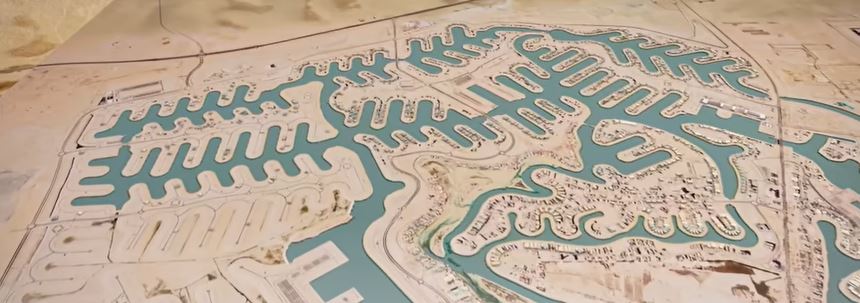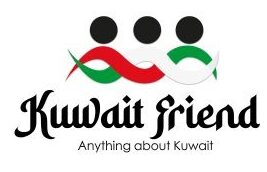Sabah Mitzi City is an infrastructure project with a very unusual approach because in this city, on a lagoon that flows straight into the sea, nearly every person has access to their own private beach. Yet building such a community requires overcoming enormous engineering challenges as project planners. Kuwait in the late 1980s was faced with a problem.
There was a great need for luxurious housing in the country, which had become rich from the export of crude oil. But the small nation lacked the space to meet this demand.
The northern and sovereign ends of Kuwait’s coast are just 105 miles apart, and by 1989, when the plans for a new city began to take shape, much of the coastal area was already built up. The capital, Kuwait City, with its adjacent outskirts and industrial suburbs, was already stretched all the way from the Kuwait bay. The inland of the desert is not very desirable for a variety of reasons. First, there are no usable resources here to supply cities. The ground is unstable and hardly suitable for construction.

And above all, there is an extremely dry heat here. Living along the coast is more desirable as the sea breeze ensures a milder climate with fewer temperature fluctuations between day and night. The idea of fixing this is simple.
Instead of building directly on the limited shoreline and creating a few new beachfront properties, one could instead dig channels that run inland, snaking through an area in such a way that there is far more water access. If you pull both of these cords straight, you can see just how massively the coast can be extended using this method.
Duration of Project
The two potential project sites were considered for the construction of this new city; one area adjacent to the Shurik district in Kuwait City and the other one, Al-Kiran, not far from the Saudi Arabian border. But just before the plants could really take shape, the entire project had to be put on hold as the nation found itself entangled in a conflict.
It ended up taking another six years until the plans for the sea city were resumed. As environmentally destructive as the past phase was for the country, this project should now focus on dealing well with the environment.
The developers chose the area in Al-Kiran and decided on an approach in which the exact form of the project is strongly guided by the natural forces of sea and wind.
The project site was characterized by two existing tidal creeks with water levels rising and falling with the tides, and aside from the Alkyron Resort, a popular recreational destination, this piece of land had not been developed based on the natural currents of these tidal creeks. At the same time, a master plan was drafted to create a complex channel system with two additional sea entrances.
But as simple as this approach seems, a number of difficulties quickly become apparent. One of them is that water quality could easily become poor due to the lack of circulation in these channels. If the water is not regularly exchanged, this promotes algae growth, and the channels could become foul-smelling salt ponds.
At the same time, the water flow flushing these channels should not be too fast because residents are supposed to swim here comfortably.
Geometrical Shape : Sabah Mitzi City
How can you be sure that these geometrically shaped canals designed on a plan will not be deformed over the years by the powerful natural forces of the water, threatening residential buildings with flooding? The planners developed a complex computer model simulating natural currents.
With this data, a schematic computer model could be created which simulates the hydrodynamic properties of the entire system. This way, additional connecting channels were introduced in areas where the simulation showed that the water flow was too fast.
Because if you introduce another channel, the water has more space to go. The flow slows down. As a side effect, the risk of coastal erosion is also reduced. But even though the adjustments based on the computer model promised improvement, it still appeared that the water exchange was too irregular in certain areas, which would result in bad water quality.
One possibility to fix this would be by simply pumping the water out of these areas, but pumping stations require a lot of energy and are expensive.
Also, such a solution means pumping will be required indefinitely, so it’s less of a solution to the problem than an elaborate workaround. Therefore, the engineers came up with another idea that would allow the lagoons to be completely flushed only by natural forces.
These gates are opened at high tide simply due to the water pressure pushing them open. However, at low tides, with the water flowing in the opposite direction, the water pushes these gates to a closed position.
Interruption of The Project
This way, the system is completely self-regulating and the computer simulation shows how the flushing of fresh water can be significantly improved using these skates. The project was finally beginning to take shape in the early 2000s, with excavators digging the first canals and the flooding of the first section with water starting in 2004.
What was done in Dubai is a very different approach to essentially the same problem of creating additional coastline. While in Kuwait, channels were dug into the barren desert to create artificial new islands.
In Dubai, sand was dredged from the sea floor to create artificial new islands. There are major differences between these two approaches, especially when it comes to their effects on the environment. While in Kuwait, the already existing natural currents and tidal creeks informed the shape of the design.
In Dubai, the form of the islands was playfully chosen to resemble the shapes of palm trees or of a world map. Constructing such a land reclamation project involves a difficult-to-solve contradiction.
On one hand, man-made islands must be protected from the forces of ocean currents, which is done with rigid breakwater rings. It’s necessary because, in the long run, these islands are not stable by themselves, as the shape of coastal land is not formed by chance but results from complex natural forces, oftentimes continuously evolving coastal landscapes over the years.
The contradiction is that by building such protective breakwater rings, this also prevents regular water exchange.
For example, while the more exposed islands in Dubai’s world project struggle with coastal erosion. The palm Jumeirah, which is better protected by the extensive breakwater, struggles with water quality problems as the water in the inner part of the palm is almost stagnant in Kuwait’s sea city.

On the other hand, the beaches located near the sea entrance were set up with clarity so that they could be shaped naturally, while the canals inside the land were not subjected to the strong ocean forces.
While the dredging and creation of land reclamation represent a harsh encroachment on species-rich marine habitats, the digging of new channels in Kuwait’s arid desert actually creates new additional habitats for marine life.
In addition, the stony breakwater in Kuwait City was only filled with mortar above the water line, leaving open underwater spaces that offer ideal habitats for marine life.
Huge Transformation
In addition, mangroves and other plants that can grow in dry conditions were planted on specifically created islands in order to structurally strengthen the marine bay and create natural habitats instead of bringing the desert into the sea.
The transformation of such a large area was an enormous challenge, and it is intrusive. With the project growing over the years and new sections being opened regularly, the planners hope to eventually house 250-000 people in this city.
Today, along the canals you mostly find residential villas, high-income apartments, some hotel resorts, and several marinas, while many plots remain undeveloped. If one understands the word “city” to mean a diverse coexistence of living spaces, office space, cultural institutions, as well as public space.
While they have transformed this area and literally moved mountains to achieve this, it appears that other aspects of modern city planning have been much less of a priority, despite the project being constructed in Kuwait, a country which owes its economic prosperity to the trade of petroleum products. In addition, there has been a strong focus on environmental solutions.
It is also noteworthy to consider that construction of this project had to be put on hold during the Gulf War because of its unprecedented catastrophic environmental impact.
Conclusion
Instead of digging artificial canals, Kuwait had to spend about 1.5 billion dollars just to extinguish fires all across the country as Iraqi soldiers withdrawing from the land in the final stages of the war had set countless oil wells on fire, an act of sabotage with far-reaching consequences because once such a fire has been set, it is almost impossible to extinguish it.
You can find more quality blogs here.


